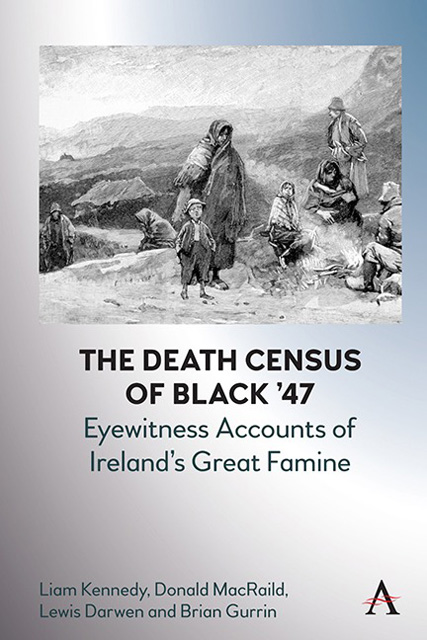Chapter Seven - The Death Census: Testimony in Context
Published online by Cambridge University Press: 17 October 2023
Summary
County Galway
Ardrahan, Kilmacduagh Diocese
Commentary
The Catholic parish of Ardrahan was in Kilmacduagh diocese at the time of the Death Census. The Catholic parish was coextensive with the civil parish of the same name. Its population was reported in the statutory censuses at 3,805 in 1831, and 4,191 in 1841 (about 1,000 more than the 3,200 inhabitants that Revd Quin estimated for his parish in 1847). This implies a rate of increase of about 1 per cent per year between 1831 and 1841. In 1841, 44 per cent of the housing was classified as fourth class and the female illiteracy rate was 81 per cent. These two measures of poverty and disadvantage are included in this and later commentaries to give a rough indication of living standards in the localities. It should be noted, however, that it is not always possible to map data precisely from civil parishes, as in the population censuses, on to Catholic parishes. This qualification is unlikely to make much difference in practice to the patterns of literacy or housing quality locally.
Patrick Bodkin Quin had long-standing connections with Ardrahan. Arriving from Peterswell parish, he had been parish priest of Ardrahan from at least as early as 1834, when he is recorded as contributing £1 to the O’Connell annuity that year. He farmed locally, was a supporter of the Repeal Association, was a prominent advocate of Catholic rights, and was a member of the Ardrahan Relief Committee during Black ‘47, when he signed a memorial to the Lord Lieutenant protesting at the temporary termination of Public Works (the memorial is replicated below). It seems reasonable, therefore, to infer that his knowledge of the locality was extensive, and he was a prime candidate to report on Famine deaths in the area. Quin did not live long beyond the submission of his report, for in early September 1847 the Galway Mercury announced his death:
We sincerely regret to be obliged to state, that another of the venerated Priesthood of Ireland has fallen a victim to that most dreadful malady, fever, and yielded up his soul into the hands of his Creator, on the morning of Sunday last [29 August].
- Type
- Chapter
- Information
- The Death Census of Black '47Eyewitness Accounts of Ireland's Great Famine, pp. 103 - 294Publisher: Anthem PressPrint publication year: 2023

